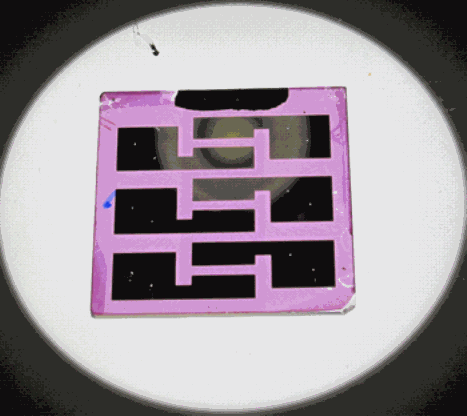A new version of solar cells created by laboratories at the Rice and Pennsylvania State universities, with an assist from the U.S. Department of Energy Office of Science’s Advanced Photon Source at Argonne National Laboratory and Advanced Light Source at Lawrence Berkeley National Laboratory, could open the door to research on a new class of solar energy devices.
The photovoltaic devices created in a project led by Rice chemical engineer Rafael Verduzco and Penn State chemical engineer Enrique Gomez are based on block copolymers, self-assembling organic materials that arrange themselves into distinct layers. They easily outperform other cells with polymer compounds as active elements.
The discovery is detailed online in the American Chemical Society journal Nano Letters.
While commercial, silicon-based solar cells turn about 20% of sunlight into electricity and experimental units top 25%, there’s been an undercurrent of research into polymer-based cells that could greatly reduce the cost of solar energy, Verduzco said. The Rice/Penn State cells reach about 3% efficiency, but that’s surprisingly better than other labs have achieved using polymer compounds.
“You need two components in a solar cell: one to carry (negative) electrons, the other to carry positive charges,” Verduzco said. The imbalance between the two prompted by the input of energy – sunlight – creates useful current.
Since the mid-1980s, researchers have experimented with stacking or mixing polymer components with limited success, Verduzco said. Later polymer/fullerene mixtures topped 10 percent efficiency, but the fullerenes – in this case, enhanced C-60 buckyballs – are difficult to work with, he said.
The Rice lab developed a block copolymer — P3HT-b-PFTBT — that separates into bands that are about 16 nanometers wide. More interesting to the team of researchers was the polymers’ natural tendency to form bands perpendicular to the glass. The copolymer was created in the presence of a glass/indium tin oxide (ITO) top layer at a modest 165º Celsius.
With a layer of aluminum on the other side of the device constructed by the Penn State team, the polymer bands stretched from the top to bottom electrodes and provided a clear path for electrons to flow.
The molecular order in the block copolymer thin films was determined via conventional x-ray diffraction at the Materials Characterization Lab of The Pennsylvania State University, and grazing incidence wide-angle x-ray scattering at the Argonne X-ray Science Division beamline 8-ID-E of the Advanced Photon Source. Resonant soft x-ray scattering at beamline 11.0.1.2 of the Advanced Light Source and grazing incidence x-ray scattering measurements, also at beamline 8-ID-E of the Advanced Photon Source, determined the basis for the enhanced performance of block copolymer devices compared to devices made from polymer blends.
“On paper, block copolymers are excellent candidates for organic solar cells, but no one has been able to get very good photovoltaic performance using block copolymers,” Verduzco said. “We didn’t give up on the idea of block copolymers because there’s really only been a handful of these types of solar cells previously tested. We thought getting good performance using block copolymers was possible if we designed the right materials and fabricated the solar cells under the right conditions.”
Mysteries remain, he said. “It’s not clear why the copolymer organizes itself perpendicular to the electrodes,” he said. “Our hypothesis is that both polymers want to be in contact with the ITO-coated glass. We think that forces this orientation, though we haven’t proven it yet.”
He said the researchers want to experiment with other block copolymers and learn to control their structures to increase the solar cell’s ability to capture photons and turn them into electricity.
See: Changhe Guo1, Yen-Hao Lin2, Matthew D. Witman1, Kendall A. Smith2, Cheng Wang3, Alexander Hexemer3, Joseph Strzalka4, Enrique D. Gomez1*, and Rafael Verduzco2**, “Conjugated Block Copolymer Photovoltaics with near 3% Efficiency through Microphase Separation,” Nano Lett. 13, 2957 (2013). DOI:10.1021/nl401420s |
Author affiliations: 1The Pennsylvania State University, 2Rice University, 3Lawrence Berkeley National Laboratory, 4Argonne National Laboratory
Correspondence: *[email protected], **[email protected]
C.G., M.D.W., and E.D.G. acknowledge financial support from the National Science Foundation under Award DMR-1056199. R.V., K.A.S., and Y.H.L. acknowledge support from the Welch Foundation for Chemical Research (Grant C-1750), the Shell Center for Sustainability, and Louis and Peaches Owen. The Advanced Light Source is supported by the Director, Office of Science, Basic energy Sciences, of the U.S. Department of Energy under Contract No. DE-AC02-05CH11231. Use of the Advanced Photon Source is supported by the U.S. Department of Energy Office of Science under Contract No. DE-AC02-06CH11357.
The original Rice University press release by Mike Williams can be found here.
The Advanced Light Source is an Office of Science User Facility operated for the U.S. Department of Energy Office of Science by Lawrence Berkeley National Laboratory.
The Advanced Photon Source at Argonne National Laboratory is one of five national synchrotron radiation light sources supported by the U.S. Department of Energy’s Office of Science to carry out applied and basic research to understand, predict, and ultimately control matter and energy at the electronic, atomic, and molecular levels, provide the foundations for new energy technologies, and support DOE missions in energy, environment, and national security. To learn more about the Office of Science x-ray user facilities, visit http://science.energy.gov/user-facilities/basic-energy-sciences/.
Argonne National Laboratory seeks solutions to pressing national problems in science and technology. The nation's first national laboratory, Argonne conducts leading-edge basic and applied scientific research in virtually every scientific discipline. Argonne researchers work closely with researchers from hundreds of companies, universities, and federal, state and municipal agencies to help them solve their specific problems, advance America's scientific leadership and prepare the nation for a better future. With employees from more than 60 nations, Argonne is managed by UChicago Argonne, LLC for the U.S. Department of Energy's Office of Science.

